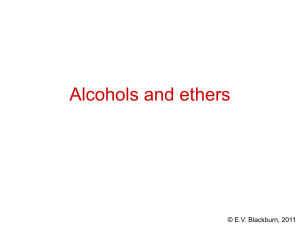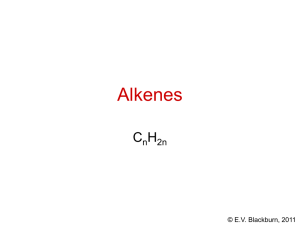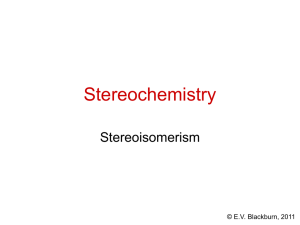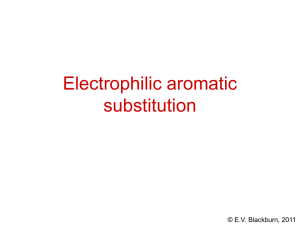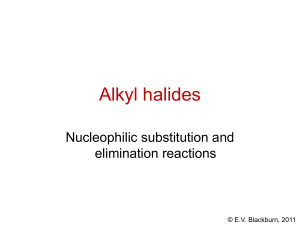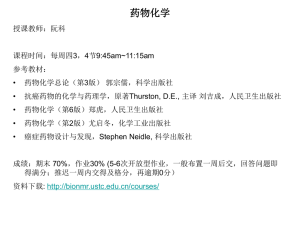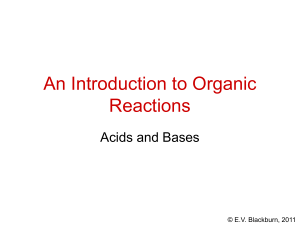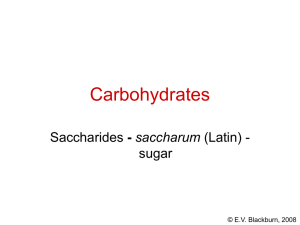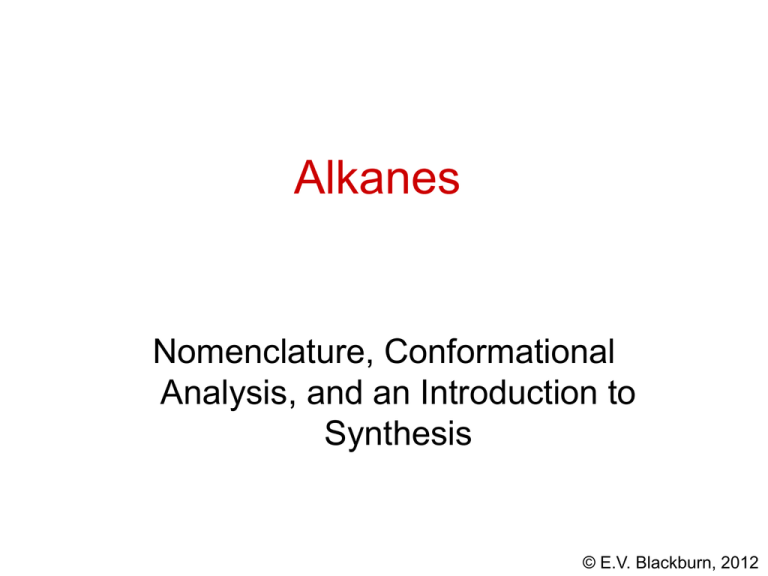
Alkanes
Nomenclature, Conformational
Analysis, and an Introduction to
Synthesis
© E.V. Blackburn, 2012
Alkanes
• acyclic hydrocarbons
• saturated aliphatic hydrocarbons
• paraffins
• general formula CnH2n+2
© E.V. Blackburn, 2012
Sources of methane
• product of anaerobic plant decay
• major constituent of natural gas (97%)
• “firedamp” of coal mines
• “marsh gas”
© E.V. Blackburn, 2012
Cycloalkanes
Single ring cycloalkanes have the general formula CnH2n
thus they have two fewer hydrogen atoms than alkanes.
© E.V. Blackburn, 2012
Methane – its structure
H
sp3
109.5o
H
H
H
tetrahedral
© E.V. Blackburn, 2012
Methane – its structure
H
H
H
H
“Fischer Structure”
H
..
:
H :C
H
..
H
“Lewis Structure”
© E.V. Blackburn, 2012
Space-filling models
Space-filling models depict atoms as spheres and
therefore show the volume occupied by atoms and
molecules.
© E.V. Blackburn, 2012
Ethane - C2H6
1.10Å
H sp H
H C C H
H 1.53Å H
3
A structural formula is a Lewis structure which shows the
connectivity of its atoms - the order in which atoms are
connected.
© E.V. Blackburn, 2012
What is ethane’s structure?
Or something in
between?
© E.V. Blackburn, 2012
Conformations
Conformations are structures that are interconvertible by
rotation about single bonds.
This is the staggered conformation of ethane:
This is an example of a sawhorse formula.
© E.V. Blackburn, 2012
Newman projections
Look along the C-C bond. The nearest carbon masks the
rear carbon but all six bonds to the two carbons are visible.
The nearest carbon is represented by the point where the
three bonds meet.
The rear carbon is represented by the circle.
staggered
eclipsed
© E.V. Blackburn, 2012
Space-filling model of ethane
staggered
eclipsed
© E.V. Blackburn, 2012
Potential energy
Stability of conformations
eclipsed
staggered eclipsed
12 kJ/mol
60o
120o
180o
rotation
© E.V. Blackburn, 2012
Torsional strain
Torsional energy is the energy required to rotate the
molecule about the C-C bond.
The relative instability of the eclipsed conformation
is said to be due to torsional strain.
© E.V. Blackburn, 2012
Propane - C3H8
H H H
H C C C H
H H H
energy barrier = 14 kJ/mol
© E.V. Blackburn, 2012
Butane - C4H10
CH3CH2CH2CH3
(CH3)3CH
CH3
H
H3C CH3
compound
bp
mp
solubility
C2H5OH
A
-12
-159
1320
B
0C
-138
1813 mL/100mL
© E.V. Blackburn, 2012
Conformations
H 3C
H
H
H
H
H
CH3
H
H
H
CH3
H
CH3
H
H
H
CH3
CH3
anti
gauche
All conformations are free of torsional strain.
© E.V. Blackburn, 2012
Stability of conformations
H 3C
H
H
H
H
H
CH3
H
H
H
CH3
H
CH3
H
H
H
CH3
CH3
anti
gauche
The methyl groups in the gauche conformations are
crowded together and steric repulsion results. These
conformations are less stable due to steric strain.
© E.V. Blackburn, 2012
Stability of conformations
anti
gauche
© E.V. Blackburn, 2012
Stability of conformations
Potential energy
H 3C
CH3
H3C
H3C
CH3
H3C
H3C
H3C
CH3
gauche
anti
19 kJ
16 kJ
3.8 kJ
© E.V. Blackburn, 2012
Nomenclature
CH4
methane
C2H6
ethane
C3H8
propane
C4H10
butane
Subsequent alkanes are systematically named using a
numeric prefix (Greek) (penta-, hexa-, etc.) and the suffix ane.
© E.V. Blackburn, 2012
Nomenclature
CH4
methane
C7H16
heptane
C2H6
ethane
C8H18
octane
C3H8
propane
C9H20
nonane
C4H10
butane
C10H22
decane
C5H12
pentane
C11H24
undecane
C6H14
hexane
C12H26
dodecane
C13H28
tridecane
C14H30
tetradecane
C20H42
icosane
C100H202 hectane
© E.V. Blackburn, 2012
n-Butane
CH3CH2CH2CH3
n- - specifies a straight chain hydrocarbon, e.g. nbutane or normal butane
(CH3)3CH
CH3
H
H3C CH3
?
© E.V. Blackburn, 2012
Prefixes......
iso- (CH3)2CHCH3
H3C C CH3
H
iso-
isobutane
© E.V. Blackburn, 2012
Pentane
CH3-CH2-CH2-CH2-CH3
n-pentane
CH3
CH3-CH-CH 2-CH3
isopentane
CH3
CH3-C-CH3
CH3
neopentane
CH3
H3C
CH3
neo
© E.V. Blackburn, 2012
Hexane
There are five alkane isomers of formula C6H14 ...
© E.V. Blackburn, 2012
n-hexane
CH3CH2CH2CH2CH2CH3
© E.V. Blackburn, 2012
isohexane
(CH3)2CHCH 2CH2CH3
CH3
H3C C CH2-CH2-CH3
H
© E.V. Blackburn, 2012
Neohexane
(CH3)3CCH2CH3
CH3
H3C C CH2CH3
CH3
© E.V. Blackburn, 2012
and ........
CH3
CH3-CH-CH-CH 3
CH3
CH3
CH3-CH2-CH-CH 2-CH3
© E.V. Blackburn, 2012
Nomenclature
Why not name these more complex alkanes by first
identifying and naming the longest carbon chain? – the
parent chain.
Then consider the groups attached to the parent chain as
substituents?
© E.V. Blackburn, 2012
Alkyl group substituents
An alkyl group is the structure obtained when a
hydrogen atom is removed from an alkane.
These groups are named by replacing the -ane suffix
of the corresponding alkane by -yl, hence “alkyl”.
• CH3-
methyl
(Me-)
• CH3CH2-
ethyl
(Et-)
• (CH3)2CH-
isopropyl
(i-Pr)
• CH3CH2CH2-
propyl
(Pr)
© E.V. Blackburn, 2012
Alkyl group substituants
• CH3-
methyl
(Me-)
• CH3CH2-
ethyl
(Et-)
• (CH3)2CH-
isopropyl
(i-Pr)
• CH3CH2CH2-
propyl
(Pr)
• CH3CH2CH2CH2-
butyl
• (CH3)2CHCH2-
isobutyl
• but …. (CH3)3C- ?
• or CH3CHCH2CH3
|
© E.V. Blackburn, 2012
alkyl group classification
• a “primary” carbon is bonded to one other carbon
• a “secondary” carbon is bonded to two carbon atoms
• a “tertiary” carbon is bonded to three carbon atoms
CH3-CH-CH 2-CH3
sec-butyl
CH3
CH3-C-CH3
tert-butyl
© E.V. Blackburn, 2012
IUPAC nomenclature
• The longest continuous carbon chain forms the basic
carbon skeleton.
• If there are two of these chains, select the one with
the greater number of branch points.
• The remaining alkyl groups are considered as
substituents.
C
C C
C C C C
© E.V. Blackburn, 2012
Nomenclature
• The carbon chain is then numbered from the end
nearer the first branch point.
• The different substituent groups are assigned
numbers based on their positions along this chain.
• Every substituent must have a number even if they
are on the same carbon.
• If identical substituents are present use the prefixes
di-, tri-, tetra- etc.
C
C C
C C C C
2,3-dimethylpentane
not
3,4-dimethylpentane
© E.V. Blackburn, 2012
Substituents
Substituents are named in alphabetical order.
C
C C
C C C C C C C
4-ethyl-3-methylheptane
© E.V. Blackburn, 2012
Hexane
CH3-CH2-CH2-CH2-CH2-CH3
CH3
CH3-CH-CH 2-CH2-CH3
CH3
CH3-CH2-C-CH3
CH3
CH3
CH3-CH2-CH-CH 2-CH3
CH3
CH3-CH-CH-CH 3
CH3
© E.V. Blackburn, 2012
Nomenclature of branched alkyl
groups
Numbering begins at the point where the group is
attached to the main chain.
© E.V. Blackburn, 2012
Nomenclature of branched alkyl
groups
© E.V. Blackburn, 2012
Nomenclature of alkyl halides
H
H3C C CH3
Cl
(CH3)3CCl
© E.V. Blackburn, 2012
Nomenclature of alcohols
Add the suffix ol to the name of longest, linear, carbon
chain which includes the carbon bearing the OH and
any double or triple C-C bond.
CH3CH2OH
ethanol
H
CH3CH2CH2CCH2OH
CH2CH3
2-ethyl-1-pentanol
The OH group has a higher priority than a multiple CC bond, a halogen, and an alkyl group in determining
the carbon chain numbering.
© E.V. Blackburn, 2012
Nomenclature of alcohols
CH2CH2OH
CH3CH2CH2OH
1-propanol
2-phenylethanol
CH3H
H3C C C CH3
H OH
3-methyl-2-butanol
© E.V. Blackburn, 2012
Nomenclature of alcohols
OH
O
H3C C C
H OH
2-hydroxypropanoic acid
© E.V. Blackburn, 2012
Other nomenclature systems
1. Name the alkyl group followed by the word alcohol:
CH3CH2OH
ethyl alcohol
CH3CHCH 3
OH
isopropyl alcohol
2. Name alcohols as derivatives of carbinol, methanol:
CH 3OH
carbinol
OH
triphenylcarbinol
© E.V. Blackburn, 2012
Vicinal glycols
“vicinal” means “adjacent” (vicinus, Latin for adjacent),
“glycol” means “diol”
Alcohols having two OH groups are called “glycols”:
HOCH2CH2OH is ethylene glycol or 1,2-ethanediol
© E.V. Blackburn, 2012
Ethers
Structure:
R-O-R, Ar-O-R, or Ar-O-Ar
nomenclature
Name the two groups bonded to the oxygen and add
the word ether.
CH3CH2OCH2CH3 - diethyl ether
© E.V. Blackburn, 2012
Nomenclature of ethers
O
diphenyl ether
CH3OCH=CH2
O
CH(CH 3)2
CH3CH2CH2CHCH2CH3
|
OCH3
methyl vinyl ether
isopropyl phenyl ether
3-methoxyhexane
© E.V. Blackburn, 2012
Nomenclature of cycloalkanes
Cycloalkanes are named by adding the prefix cyclo to
the name of the corresponding n-alkane.
Br
cyclopropane
Br
1,3-dibromocyclohexane
Br
Cl
1-bromo-2-chlorocyclopentane
© E.V. Blackburn, 2012
Bicyclic compounds
Use the name of the alkane corresponding to the total
number of carbons in the rings as the parent:
Seven carbons – a bicycloheptane.
Now determine the number of carbons in each bridge and
place them in the name in order of decreasing length.
Bicylo[2.2.1]heptane!
© E.V. Blackburn, 2012
Bicyclic compounds
bicyclo[2.1.0]pentane
bicylco[3.1.1]heptane
Number the carbons beginning at one bridgehead, along
the longest bridge, then the next longest back to the
original bridgehead, then along the shortest bridge.
H 3C
7
5 4 3
6
7-methylbicyclo[2.2.1]heptane
1 2
© E.V. Blackburn, 2012
Bicyclic compounds
© E.V. Blackburn, 2012
Nomenclature of cyclic ethers
Use the prefix oxa- to indicate that an O replaces a CH2
in the ring.
oxacyclopropane
O
O
ethylene oxide
oxacyclopentane
tetrahydrofuran
O
1,4-dioxacyclohexane
O
1,4-dioxane
© E.V. Blackburn, 2012
Nomenclature of alkenes
1. To name alkenes, select the longest carbon
chain which includes the carbons of the double
bond. Remove the -ane suffix from the name of the
alkane which corresponds to this chain. Add the
suffix -ene.
C
C
C C C C C C C C
a derivative of heptene not octane
© E.V. Blackburn, 2012
Nomenclature of alkenes
2. Number this chain so that the first carbon of the
double bond has the lowest number possible.
1
C
C2
C C C C C C C C
3
4
5
6
7
3-propyl-1-heptene
© E.V. Blackburn, 2012
Nomenclature of alkenes
1
3-chlorocyclohexene
2
3
Cl
vinyl
H
H
allyl
H2C=CHCH 2-
H
H2C=CHCl
H 2C=CHCH 2OH
© E.V. Blackburn, 2012
Butene - C4H8
The following are
obviously butenes:
CH3CH2CH=CH 2
1-butene
CH3CH=CHCH 3
2-butene
CH3C=CH 2
CH3
methylpropene
However there are four alkenes of formula C4H8!
compound
A
B
C
D
bp
mp
-7C -141C
-6C < -195C
+1C -106
+4C -139C
© E.V. Blackburn, 2012
The butenes - C4H8
compound
A
B
C
D
bp
mp
-7C -141C
-6C < -195C
+1C -106
+4C -139C
B, C, and D
A
H2
Pt, Pd
or Ni
H2
Pt, Pd
or Ni
H2/Pt
H H
CH3CH2CH2CH3
CH3
H3C-C-CH 3
H
“A” must be methylpropene!
© E.V. Blackburn, 2012
The butenes - C4H8
compound
A
B
C
D
bp
mp
-7C -141C
-6C < -195C
+1C -106
+4C -139C
methylpropene
i. O3
ii. (CH3)2S
B
1. O3
2. (CH3)2S
O O
H2C=O + CH 3CH2C=O
H
“B” is 1-butene
© E.V. Blackburn, 2012
The butenes - C4H8
compound
A
B
C
D
bp
mp
-7C -141C
-6C < -195C
+1C -106
+4C -139C
methylpropene
1-butene
1. O3
C and D
2. (CH3)2S
CH3C=O
H
C and D: CH3CH=CHCH 3
© E.V. Blackburn, 2012
2-butene
H3C
H
C C
H
CH3
trans
H3C
CH3
C C
H
H
cis
© E.V. Blackburn, 2012
Nomenclature
Replace the -ane ending of the parent alkane with -yne.
The numbering is analogous to that for alkenes.
H C C C2H5
H3C C C CH3
1-butyne
2-butyne
H3C C C CH(CH 3)2
4-methyl-2-pentyne
© E.V. Blackburn, 2012
Nomenclature
“Enynes” are compounds containing both a double and a
triple bond.
Numbering of the chain starts from the end nearer to the
first multiple bond, be it double or triple.
CH3
HC CCH2CHCH2CH2CH=CHCH3
4-methyl-7-nonen-1-yne
HC CCH2CH2CH=CH 2
1-hexen-5-yne
© E.V. Blackburn, 2012
Physical properties of alkanes
and cycloalkanes
• non-polar
• low melting point (-183C for methane)
• low boiling point (-161.5C for methane)
• colorless
• insoluble in water
• soluble in non-polar solvents such as petrol, ether, etc.
© E.V. Blackburn, 2012
Cyclopropane
Ni/H 2
o
X
80
Br2/CCl4
H3O+
Y
HI
CH3CH2CH3
CH2BrCH2CH2Br
CH3CH2CH2OH
CH3CH2CH2I
© E.V. Blackburn, 2012
Cyclobutane
H2/Ni
o
200
CH3CH2CH2CH3
© E.V. Blackburn, 2012
Relative stabilities of cycloalkanes
Baeyer (1885) proposed that rings smaller and larger
than cyclopentane were unstable due to angle strain.
How does this hypothesis fit the facts?
Angle strain in cyclic compounds can be quantitatively
evaluated by comparing heats of combustion for each CH2- unit.
© E.V. Blackburn, 2012
Heats of combustion/CH2
Cyclane (CH2)n
n
n-alkane
H/n (kJ)
658.6
cyclopropane
3
697.0
cyclobutane
4
686.0
cyclopentane
5
664.0
cyclohexane
6
658.7
cycloheptane
7
662.4
cyclooctane
8
663.8
cyclopentadecane 15
659.0
free of angle strain
free of angle strain!!!
Why?
© E.V. Blackburn, 2012
Cyclanes have puckered, not
flat rings:
H
H
H
H
H
H
H
H
cyclobutane
H
HH H
H
H
H
H HH
cyclopentane
H
H
H H
H
H
H
H
H H
H
H
cyclohexane
© E.V. Blackburn, 2012
Conformational analysis angle strain
Any atom tends to have bond angles that match those
of its bonding orbitals: 109.5o for sp3-hybridized
carbons.
Any deviation from these normal bond angles is
accompanied by angle strain.
© E.V. Blackburn, 2012
Conformational analysis torsional strain
Any pair of sp3 carbons bonded to each other tend to
have their bonds staggered. Any deviation from the
staggered conformation is accompanied by torsional
strain.
© E.V. Blackburn, 2012
Conformational analysis - van
der Waals strain
Non-bonded atoms that just touch one another attract
each other. If they are closer, they repel each other.
Such crowding is accompanied by van der Waals strain
(steric strain).
© E.V. Blackburn, 2012
Cyclohexane - the “chair”
conformation
H
H
H H
H
H
H
H
H
H
H
H
© E.V. Blackburn, 2012
The “boat” conformation
"flag pole"
hydrogens
1.83A
H
H
H H
H
H
H
H
H
H
H
H
This conformation is less stable (29.7 kJ/mol) than the
chair conformation. It is situated at the top of a PE curve
and is therefore a transition state between 2
conformational isomers.
© E.V. Blackburn, 2012
Skew-boat conformations
H
H
H
H
"boat"
"skew-boat"
The skew-boat conformations are 23.0 kJ/mol less
stable than the chair conformation.
© E.V. Blackburn, 2012
Conformations of cyclohexane
6.7 kJ
E
45 kJ
23 kJ
© E.V. Blackburn, 2012
Axial and equatorial
hydrogens
Ha
Ha
Ha
He
He
He
Ha
Ha
He
He
Ha
Ha = axial
He
He= equatorial
© E.V. Blackburn, 2012
Axial and equatorial
hydrogens
Ha
Ha
He
Ha
He
He
He
He
Ha
Ha = axial
He
Ha
Ha
He= equatorial
© E.V. Blackburn, 2012
Axial and equatorial
hydrogens
axial
equatorial
© E.V. Blackburn, 2012
Methylcyclohexane equatorial
H
H
H H
H
CH3
H
H
H
H
H
H
© E.V. Blackburn, 2012
Methylcyclohexane - axial
1,3 diaxial
interaction
H
CH3
H
3
1
H
3
© E.V. Blackburn, 2012
trans-1,2-dimethylcyclohexane
H
H
H H
H
CH3
H
CH3
H H
H
H
H
CH3
H H
H
H
H
H
H
H
H
CH3
© E.V. Blackburn, 2012
cis-1,2-dimethylcyclohexane
H
CH3
H H
H
H
H
CH3
H
H
H
H
H
H
H H
H
CH3
H
H
H H
H
CH3
© E.V. Blackburn, 2012
cis v trans
H
H
H H
H
CH3
H
CH3
H
H
H
H
H
CH3
H H
H
H
H
CH3
H H
H
H
© E.V. Blackburn, 2012
cis-1,3cis
cis
© E.V. Blackburn, 2012
trans-1,3-
trans
© E.V. Blackburn, 2012
trans-1,4-
trans
?
© E.V. Blackburn, 2012
cis-1,4-
cis
© E.V. Blackburn, 2012
Nomenclature
CH3
Br
CH3
OH
Br
Cl
Cl
C(CH 3)3
I
Br
© E.V. Blackburn, 2012
Synthesis of alkanes and
cycloalkanes
© E.V. Blackburn, 2012
Hydrogenation of alkenes and
alkynes
H2
CnH2n
CnH2n+2
Pt, Pd or Ni
alkane
alkene
H2/Ni
C2H5OH
25o, 50 atm
(CH3)3CH
© E.V. Blackburn, 2012
Hydrogenation of alkenes and
alkynes
+ 2 H2
+ H2
Pt
Pd
© E.V. Blackburn, 2012
Reduction of alkyl halides
peroxide
RX + Bu3SnH
RH + Bu 3SnX
Bu = CH 3CH2CH2CH2Bu3SnH = tri-n-butylstannane
CH3Cl + Bu3SnD
CH3D + Bu3SnCl
© E.V. Blackburn, 2012
Alkylation of terminal alkynes
An acetylenic hydrogen is weakly acidic:
R C C H
Na
NH 3
(CH3)2CHC C H
-
R C C Na + + 1/2H2
a sodium
acetylide
NaNH 2
ether
(CH3)2CHC C
-
Na +
+ NH 3
© E.V. Blackburn, 2012
Alkylation of terminal alkynes
The anion formed will react with a primary halide:
R C C- Na + + CH 3X
R C CCH 3 + NaX
1. NaNH 2
2. CH3Br
H2/Pt
© E.V. Blackburn, 2012
Corey – Posner – Whitesides House Synthesis
R-X + 2Li
1o, 2o,
or 3o
2RLi + CuI
diethyl ether
R2CuLi + R'X
RLi + LiX
alkyllithium
R2CuLi + LiI
lithium
dialkylcuprate
a Gilman reagent
R-R' + RCu +LiX
1o alkyl or 2 o
cycloalkyl halide
© E.V. Blackburn, 2012
Retrosynthetic analysis
target
molecule
1st precursor
starting compound
2nd precursor
Here is a target molecule. Plan a synthesis.
CH3CH2CHCH 2CH2CH2CH2CH3
CH3
© E.V. Blackburn, 2012
Retrosynthetic analysis
CH3CH2CH
CH2CH2CH2CH2CH3
CH3
CH3CH2CH
CH3
CuLi
BrCH2CH2CH2CH2CH3
2
1. Li
2. CuI
CH3CH2CHBr
CH3
© E.V. Blackburn, 2012
Retrosynthetic analysis
CH3CH2CHBr
1. Li
2. CuI
CH3
(CH3CH2CH) 2CuLi
CH3
(CH3CH2CH) 2CuLi
BrCH2CH2CH2CH2CH3
CH3
CH3CH2CHCH 2CH2CH2CH2CH3
CH3
© E.V. Blackburn, 2012
Corey – Posner – Whitesides House Synthesis
Muscalure is the sex pheromone of the common house fly.
It is used to attract flies to traps containing insecticide. It
can be synthesized by the Corey - House reaction. What
lithium dialkylcuprate would you use?
H3C(H2C)7 (CH2)7CH2Br
H
?
H3C(H2C)7 (CH2)12 CH3
H
H
H
Muscalure
(CH3(CH2)3CH2)2CuLi
© E.V. Blackburn, 2012
Reactions of alkanes with
halogens
250-400o
C H + X2
Reactivity:-
or h
C X + HX
X2 : F2 > Cl2 > Br2 (> I2)
H : 3 o > 2o > 1o > H3C-H
© E.V. Blackburn, 2012
Chlorination - a substitution
reaction
CH4 + Cl2
h
or
CH3Cl + HCl
© E.V. Blackburn, 2012
Polychlorination
CH3Cl + Cl2
CH2Cl2 + Cl2
CH2Cl2 + HCl
dichloromethane
methylene chloride
CHCl3 + HCl
trichloromethane
chloroform
CHCl3 + Cl2
CCl4 + HCl
tetrachloromethane
carbon tetrachloride
© E.V. Blackburn, 2012
A Problem?
Chlorination leads to the possible formation of
four products - a mixture! How can we limit the
reaction so that only one product is formed?
© E.V. Blackburn, 2012
Bromination
Bromination takes place less readily than chlorination but
it produces the four analogous brominated products:
• bromomethane
• dibromomethane -methylene bromide
• tribromomethane - bromoform
• tetrabromomethane - carbon tetrabromide
© E.V. Blackburn, 2012
Iodination and fluorination
• iodine does not react
• fluorine reacts very readily
order of halogen reactivity:
F2 > Cl 2 > Br 2 (> I2)
© E.V. Blackburn, 2012
A Mechanism
• a detailed, step by step, description of the transformation
of reagents into products
• it must explain all experimental facts
• the mechanism should be tested by devising
appropriate experiments - mechanistic predictions must
be tested in the lab
© E.V. Blackburn, 2012
Mechanism of the chlorination
of methane
The experimental facts
1. No reaction occurs at room temperature in the absence
of light.
2. Reaction readily occurs, in the absence of light, at
temperatures above 250C.
3. Reaction occurs at room temperature in the presence of
light of a wavelength absorbed by chlorine.
© E.V. Blackburn, 2012
The experimental facts
4. When the reaction is initiated by light, a large number of
chloromethane molecules are produced for each photon of
light absorbed by the system.
5. The presence of even a small quantity of oxygen slows
down the reaction.
© E.V. Blackburn, 2012
The mechanism?
1. Cl Cl
2. Cl
3. H3C
h
or
H CH3
Cl Cl
2Cl
CH3
+ HCl
CH3Cl + Cl
2, 3, 2, 3, 2 etc.
© E.V. Blackburn, 2012
Chain Reaction
Chain initiation:
Cl-Cl
2Cl
Chain propagation:
Cl + CH 4
CH3 + Cl2
Chain termination:
2Cl
2CH3
Cl + CH 3
CH3 + HCl
CH3Cl + Cl
Cl2
C2H6 (ethane)
CH3Cl
© E.V. Blackburn, 2012
Inhibitors
CH3 + O2
CH3-O-O
a "peroxy" radical
A compound which slows down or stops a reaction,
even when present in small quantities, is called an
inhibitor.
© E.V. Blackburn, 2012
Lets test the mecanism
If tetraethyllead is heated at 140C......
(C2H5)4Pb
Pb + 4C2H5
F. Paneth and W. Hofeditz, Ber., 62, 1335 (1929)
© E.V. Blackburn, 2012
An alternative source of
chlorine atoms.....
(C2H5)4Pb
C2H5 + Cl2
140 C
Pb + 4C2H5
C2H5Cl + Cl
© E.V. Blackburn, 2012
The test
(C2H5)4Pb
Pb + 4C 2H5
C2H5 + Cl2
C2H5Cl + Cl
CH4 + Cl2
140C
0.02%
(C2H5)4Pb
CH3Cl + HCl
© E.V. Blackburn, 2012
Heat of reaction
H - CH3 + Cl - Cl
Cl - CH3 + H - Cl
438 kJ
351 kJ
243 kJ
681 kJ
432 kJ
783 kJ
H = + 438 + 243 - 351 - 432 = -102 kJ
© E.V. Blackburn, 2012
Bromination
H - CH 3 + Br - Br
Br - CH3 + H - Br
438 kJ
293 kJ
193 kJ
631 kJ
366 kJ
659 kJ
H = + 438 + 193 - 293 - 366 = -28 kJ
© E.V. Blackburn, 2012
Iodination
H - CH 3 + I - I
438 kJ
151 kJ
I - CH3 + H - I
234 kJ
589 kJ
298 kJ
532 kJ
H = + 438 + 151 - 234 - 298 = +57 kJ
ENDOTHERMIC!!!
© E.V. Blackburn, 2012
Chlorination
H = - 102 kJ..........
Cl - Cl
243 kJ
Cl + H - CH 3
438 kJ
Cl - Cl + CH3
243 kJ
H
2Cl
243 kJ
Cl - H + CH 3
432 kJ
Cl
+ 6 kJ
+ Cl - CH 3
351 kJ
- 108 kJ
© E.V. Blackburn, 2012
How does Cl. react with CH4?
In order for chlorination to occur, a Cl. and a CH4 must
collide.
The H-Cl bond can only form if the two species come in
contact.
A certain minimum energy must be provided by the
collision in order for reaction to occur.
Why?????
© E.V. Blackburn, 2012
Activation energy
Bond breaking and bond formation are not perfectly
synchronous processes. Therefore energy liberated
during bond formation is not completely available for
bond breaking.
A collision must therefore provide a certain minimum
amount of energy for reaction to occur. This is called the
“activation energy”, Ea.
© E.V. Blackburn, 2012
Potential energy diagrams
Potential energy
CH4 + Cl
CH3 + HCl
Ea = 16.7 kJ
H = +6 kJ
CH3. + HCl
CH4 + Cl
Reaction coordinate
© E.V. Blackburn, 2012
Potential energy
Potential energy diagrams
© E.V. Blackburn, 2012
Reaction rates
rate =
collision x energy
factor
frequency
x probability
factor
(orientation)
© E.V. Blackburn, 2012
Factors affecting collision
frequency
• concentration
• pressure
• molecular size
• momentum
• temperature
© E.V. Blackburn, 2012
The probability factor
• depends on reactant geometry
• depends on the nature of the
reaction taking place
© E.V. Blackburn, 2012
The energy factor
• depends on temperature
• depends on activation energy
© E.V. Blackburn, 2012
KE distribution among
collisions
Number of collisions
of particular energy
E1
E2 > E1
E2
Energy
© E.V. Blackburn, 2012
Fraction of collisions with E
> Ea
= e
-Ea/RT
© E.V. Blackburn, 2012
Relative rates of reaction
rate =
collision x energy
factor
frequency
x probability
factor
(orientation)
Cl + CH 3-H
HCl + CH 3
H E a
(kJ) (kJ)
+6 16.7
Br + CH3-H
HBr + CH 3
+72
75.3
© E.V. Blackburn, 2012
Relative rates of reaction
At 275C, of every 15 million collisions, 375,000
are of sufficient energy to cause reaction when
chlorine atoms are involved …
and only one is of sufficient energy when bromine
atoms are involved.
Thus, solely due to Ea differences, the chlorine
atom is 375,000 more reactive than the bromine
atom.
© E.V. Blackburn, 2012
Relative reactivity of halogens
X =
X2
2X
F
Cl
Br
I
H = +142 +243 +193 +151 kJ
X + CH4
CH3 + HX
-134
+6
+72 +140 kJ
CH3 + X2
CH3X + X
-293 -108 -100
-83 kJ
© E.V. Blackburn, 2012
Obed Summit
© E.V. Blackburn, 2012
Rate determining step
Obed Summit
Potential energy
Rate determining
step
Cl +
CH4
CH3Cl + Cl
Reaction coordinate
© E.V. Blackburn, 2012
Transition state
Potential energy
transition state
Ea
reagents
H
products
Reaction coordinate
© E.V. Blackburn, 2012
Transition state
H
H C H +X
H
H
H C + HX
H
H
H C H +X
H
H
H C
H
H
H C H +X
H
H
H C
H
H
X
H
H C + HX
H
X
H
H C + HX
H
© E.V. Blackburn, 2012
Transition state
H
H C H +X
H
H
H C H
H
X
H
H C + HX
H
H
H C H +X
H
H
H C H
H
X
H
H C + HX
H
transition state
© E.V. Blackburn, 2012
Transition state
+ HCl
+ Cl-
?
H
+
Cl
H
Cl
1.
2.
H
Cl -
3.
© E.V. Blackburn, 2012
Halogenation
CH3CH3
CH3CH3
Cl2
Br2
h
CH3CH2Cl
chloroethane
CH3CH2Br
bromoethane
© E.V. Blackburn, 2012
Chlorination of propane
CH3CH2CH3
Cl2
CH3CH2CH2Cl + CH3CHCH 3
h
Cl
1-chloropropane
43%
2-chloropropane
57%
© E.V. Blackburn, 2012
Bromination of propane
CH3CH2CH3
Br2
CH3CH2CH2Br + CH3CHCH 3
h
Br
1-bromopropane
3%
2-bromopropane
97%
© E.V. Blackburn, 2012
Halogenation of isobutane
CH3
CH3CHCH 3
Cl2
(CH3)2CHCH 2Cl + (CH 3)3CCl
h
64%
CH3
CH3CHCH 3
Br2
36%
(CH3)2CHCH 2Br + (CH 3)3CBr
h
trace
>99%
Why this selectivity?
© E.V. Blackburn, 2012
Mechanism of the
halogenation
1. X2
250-400o
2X
initiation
or h
2. X + RH
HX + R
propagation
3. R + X2
RX + X
2, 3, 2, 3, 2, 3....etc.
© E.V. Blackburn, 2012
The intermediate alkyl radical
The nature of the intermediate free radical determines the
product:
X
CH4
methane
CH3CH3
ethane
CH3
X2
methyl radical
X
CH3CH2
ethyl radical
CH3X
halomethane
X2
CH3CH2X
haloethane
© E.V. Blackburn, 2012
The intermediate alkyl radical
CH3CH2CH3
propane
X
CH3CH2CH2
n-propyl radical
CH3CHCH 3
isopropyl radical
X2
CH3CH2CH2X
1-halopropane
X2
CH3CHXCH 3
2-halopropane
© E.V. Blackburn, 2012
Orientation of halogenation
abstraction of a
primary hydrogen
H H H H
H C C C C HX
H H H H
H H H H
H C C C C
H H H H
H H
H
H C C C C H
H H H H
abstraction of a
secondary hydrogen
We have competing reactions and should review factors
which influence reaction rates!
© E.V. Blackburn, 2012
Reaction rates
rate =
collision x energy
factor
frequency
x probability
factor
(orientation)
© E.V. Blackburn, 2012
Probability factor
The statistical product ratio for the chlorination of propane
is 75% 1-chloropropane and 25% 2-chloropropane, a 3:1
mixture.
Why? There are three times as many primary hydrogens.
However:
CH3CH2CH3
Cl2
CH3CH2CH2Cl + CH3CHCH 3
h
43%
Cl
57%
© E.V. Blackburn, 2012
Relative reactivities
Lets look at the relative reactivities per hydrogen atom:
tertiary secondary primary
Chlorination:
5.0
:
3.8
:
1.0
Bromination: 1600
:
82
:
1
We need to look at activation energies and transition
states!
© E.V. Blackburn, 2012
Transition state for rate
determining step
C H+ X
C H
X
C + HX
the carbon is
developing
free radical
character
So let us look at the stability of free radicals….
© E.V. Blackburn, 2012
Free radical stability
H3C-H CH3. + H.
H = 438 kJ
CH3CH2-H CH3CH2. + H.
H = 420 kJ
(CH3)2CH-H (CH3)2CH. + H.
H = 401 kJ
(CH3)3C-H (CH3)3C. + H.
H = 390 kJ
Order of free radical stability is therefore
tertiary > secondary > primary > methyl
© E.V. Blackburn, 2012
Free radical stability hyperconjugation
Using the concept of resonance:-
H H
H C C
H H
H H
H C C
H H
H H
H C C
H H
H H
H C C
H H
A charged system is stabilized when the charge is
dispersed or delocalized. Thus the order of free radical
stability is tertiary > secondary > primary > methyl.
© E.V. Blackburn, 2012
Free radical stability hyperconjugation
The electrons are delocalised through overlap of a p
orbital which is occupied by one, lone electron, and a
orbital of the alkyl group:
H
H
H
H
H
ethyl radical
© E.V. Blackburn, 2012
Free radical stability hyperconjugation
H
H
H
H
H
H
H
H
ethyl radical
H
H
H
H
H
H
H
H
H
isopropyl radical
H
H
H
tert-butyl radical
© E.V. Blackburn, 2012
Transition state for rate
determining step
C H+ X
C H
X
C + HX
the carbon is
developing
free radical
character
Factors which stabilize free radicals will stabilize the
transition state which is developing free radical character.
© E.V. Blackburn, 2012
Orientation of halogenation
This is determined by the stability of the transition state
for the rate determining step.
CH3
H3C C CH2 H Br
H
CH3
H3C C H
CH3
E
Br
Ea1 > Ea2
(CH3)2CHCH 2
Ea1
(CH3)3CH + Br
+ HBr
Ea2
(CH3)3C
+ HBr
(CH3)3CH + Br
Reaction coordinate
© E.V. Blackburn, 2012
Reactivity and selectivity and
the Hammond postulate
The postulate states that the transition state resembles the
structure of the nearest stable species. Transition states for
endothermic steps structurally resemble products whereas
transition states for exothermic steps structurally resemble
reactants.
Thus the later the transition state is attained in the reaction,
the more it resembles the products.
In other words, the greater the Ea, the more the transition
state resembles the products.
This will explain the greater selectivity of the bromine atom.
© E.V. Blackburn, 2012
Reactivity and selectivity
R H + Cl
R H
Cl
R + HCl
This reaction has a low activation energy and so the
transition state resembles the reactants - it has little
radical character.
R H + Br
R
H Br
R + HBr
The activation energy for the bromination is far higher. The
transition state has considerable radical character.
The free radical stabilizing factors are far more important in
the bromination, hence the greater selectivity.
© E.V. Blackburn, 2012
Synthesis of alkanes
• Hydrogenation of alkenes and alkynes
• Reduction of halides
• Corey - Posner, Whitesides – House Synthesis
© E.V. Blackburn, 2012
Reactions of alkynes
• Alkylation of terminal alkynes
• Hydrogenation
© E.V. Blackburn, 2012
Reactions of alkanes
• Halogenation
© E.V. Blackburn, 2012

